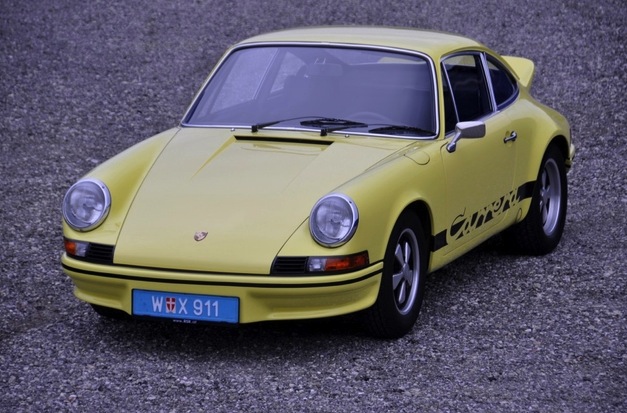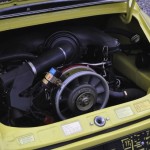Throughout the history of the Porsche 911, the range has been defined as much by its bread and butter models as it has been by the limited production versions. When discussing rare 911s, a few cars come to mind. The 1989 Club Sport. The Speedster. And this car. The 911 Carrera RSH. The 1972 to 1973 RS, or Rennsport, was a product of Porsche’s desire to broaden their reach in the Group 4 GT racing series. The RS was available in four variations, and this car for sale here is the rarest: the RSH. This was the most basic, stripped out model of them all, and weighed a mere 2,117 lbs., as was required for homologation by the German government. Only 17 were ever produced, making this one of the least common 911s of all time.
1973 Porsche 911 Carrera RSH on eBay
Vehicle is located in Europe. The odometer reads in KM so the reading of 10660 most likely exceeds its mechanical limits.
Chassis 9113601470. You are looking at neither a 471 or 472 Carrera RS. This is the rarest of all 4 variations; The RSH. Only 17 were ever constructed which accounts for 1% of total production. For comparison, Porsche built 1,308 472, 200 471 and 55 RSR models. We are not aware of any RSHs trading hands privately or at auction. In terms of significance and desirability it may be compared to the 1967 911R.
To clarify, it should be noted that using ‘RSH’ in our description denotes the 17 cars that were left unconverted by Porsche and should not be confused with the word ‘homologation’ which is used to describe the first and second batch of 500 cars built to satisfy racing requirements.
What makes the RSH model unique among Carrera RSs is its specification, or rather, lack thereof. It is approximately 30kg lighter than the 471 RS ‘Lightweight’ and 130kg lighter than the 472 RSL ‘Touring’. It was not easy for Porsche to register the RS for the road. The German government required dealers to fill out two order forms, the first for homologation and the second to convert the car. After an RSH was built stripped of most of it’s trim, it was taken to the scales to meet the 960kg weight requirement for homologation. It was then brought back to the factory for conversion to 471 or 472 spec, which mostly involved reinstalling the trim that was removed. Changes almost every other week occurred from the beginning to the end of production but there are similarities between unconverted RSH models to distinguish them from the 471 and 472 models; deletion of door caps, no trunk carpet, 6 inch Fuchs on all four corners with 185/15 tubeless front tires & 215/60/15 tube rear tires (early cars used mostly Pirelli CN36s, later cars used a mixture of Dunlops and Pirellis), deletion of the glove box door, removal of passenger seat, both sunvisors, coat hooks, trunk carpet, compressor, tools and hood shocks. There was a wooden steering box cover. Not all of these items were deleted or changed on every RSH so they can not be considered standard across all 17 cars. For example, Chassis 1470 has the glove box door, drivers sunvisor and trunk shocks installed. Since Porsche had fulfilled its homologation requirement after 1000 cars were built, they slowly began incorporating production parts to substitute for the lighter weight items across all models, RS, RSL and RSH. Lighter .8mm body panels were swapped to production spec .88mm panels, Thinner 3-3.5mm Glaverbel glass was changed to 4-5mm Sigla production glass, Ducktail spoiler construction switched from aluminum/fiberglass to steel/fiberglass, the hood badge on the RS and RSH was swapped from a decal to a metal badge, and the rubber hood and trunk catches on RS and RSH were swapped for production internal release cables and metal latches. Some late RS 471s are known to have pop out rear quarter windows and metal bumpers the same as their heavier RSL 472 counterparts. Chassis 1470 is obviously a later build car and most these details are present and correct.
The RSH model continued to be ordered even after the requisite 1000 cars had been built to satisfy homologation rules; Starting with chassis #19 and continuing periodically until chassis #1555, 17 customers decided to leave their RSH unconverted in order to go racing or possibly lock them away forever (!). One idea posited for why RSHs continued to be built after the requirements for racing were satisfied is so new parts could be homologated for production. The build date of this car coincides with the introduction of the modified rear trailing arm mounts. The last RSH built also seems to coincide with the introduction of alloy engine cases later seen on the RS 3.0. This car is also unusual in that it was never raced. It has lived in Germany and Switzerland. It was restored 9 years ago and returned to its original Light Yellow color. The incorrect Light Ivory color tag was installed from an older respray and the correct tag will be installed prior to sale. The original engine was replaced by the factory long ago. The gearbox is original. The only factory option fitted to this car is the locking differential.The original rear 6 inch Fuchs are available in addition to the 7’s currently mounted. The car is documented in the Carrera RS book written by Dr Konradsheim. Instead of a 471 or 472 next to its chassis number there is a 0. Dr Konradsheim has entrusted us to handle the transaction on behalf of his client in Germany.
The 2 photos of the White/Red RS are this same car. They were taken prior to restoration.
The more common RS Lightweights are ranging on average between $300,000 and $500,000 today, so this is a hefty premium to pay for exclusivity. It’s almost impossible to place a definitive value on a car like this. So few exist, rarely do they come up for sale and when they do, the sale price will be dictated by external forces such as the state of the economy. I’m guessing the asking price might be a bit on the high side here, but you never know. If the right buyer comes along, it might find itself in a new home. Paging Seinfeld…
-Paul







Does the fact that the engine is not original to the car affect it’s value?
David,
In every case I can think of, the lack of an original engine will most certainly be a negative with collectors. This is the rarest of the RS 911s, so I’m sure it will carry a premium over your typical RS and RSRs. How much remains to be seen. I think the price is a bit optimistic. If I had to take a stab, I’d guess somewhere around $675,000 might be what we are looking at.
Paul